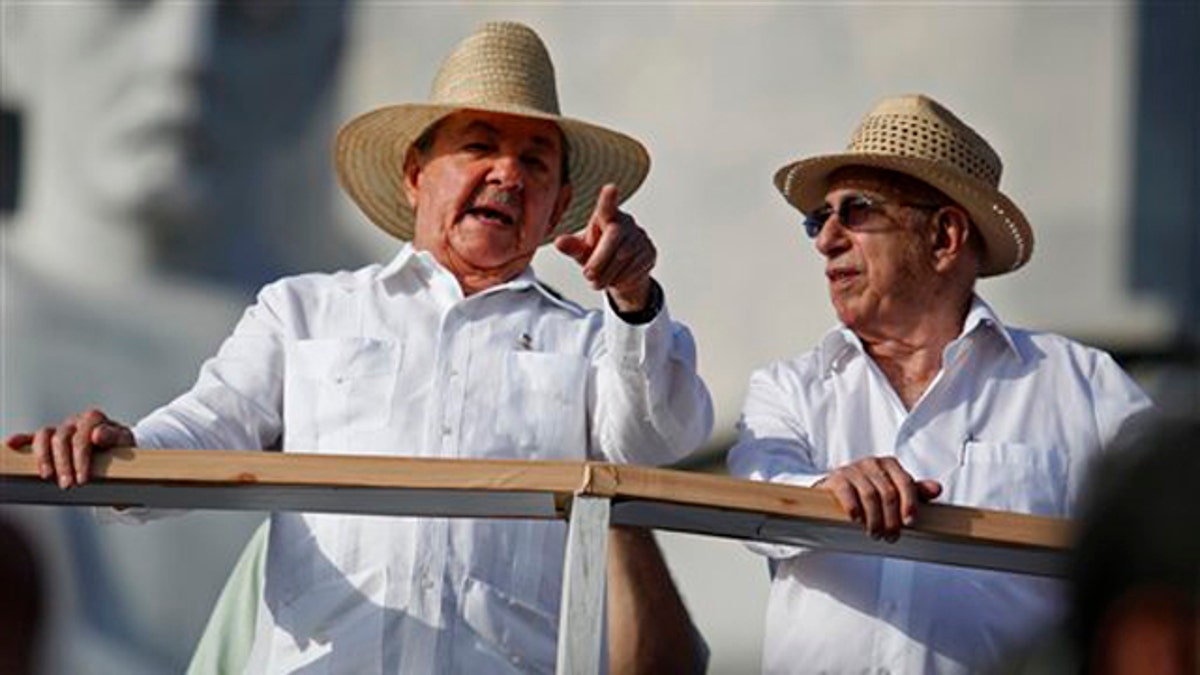
In this photo taken May 1, 2010, Cuba's President Raul Castro, left, wearing a guayabera dress shirt, speaks with Vice President Jose Ramon Machado Ventura during Labor Day celebrations in Havana, Cuba. A resolution from the Foreign Relations Ministry published into law on Oct. 6, 2010 makes the guayabera Cuba's official dress garment and mandates that all government officials wear them at state functions. (AP Photo/Javier Galeano)
A resolution from the Foreign Relations Ministry published into law Wednesday makes the guayabera Cuba's official formal dress garment and mandates that government officials wear them at state functions.
The law confirms the decades-old reputation of the cool, roomy cotton or linen shirts — with four large pockets and pleats down the front, traditionally worn untucked — as the island's quintessential fashion choice.
"The guayabera has been a part of the history of our country for a long time and constitutes one of the most authentic and legitimate expressions of Cubanism," the resolution said.
According to the law, male officials are to wear white, long-sleeved guayaberas at state events; women can vary color and style.
Nearly all Cuban officials already shun suits and sport jackets in the tropical heat, so the law isn't likely to change much.
The guayabera also is a fashion fixture in Mexico, parts of Florida and even as far away as the Philippines. It is said to have originated in this country, though no one is sure exactly where or when.
Cuban legend has it the shirt was born in the early 1700s in the central province of Sancti Spiritus, on the banks of the Yayabo River, where families of recent Spanish immigrants fashioned light work sheets out of linen and equipped them with pockets where they could stuff enough cigars to get them through long days in the fields.
The local river may have inspired the garment's name, though some insist the shirt was designed to fill its many pockets with guava fruit — and that the name comes from that.
The resolution offered no definitive answer as to the shirts' origin, but gave the tradition a political and socio-economic spin: Guayaberas "have been worn with pride and satisfaction" by Cubans of all backgrounds, it said, "evolving from their rural roots to reach various sectors of the urban population."
In Castro's case, his wardrobe shift came during a 1994 summit in Colombia, and only then at the urging of his friend, Nobel Prize-winning author Gabriel García Márquez.
In 2007, Cuba opened a guayabera museum in the city of Sancti Spiritus, capital of the province of the same name, and the shirt has symbolic value predating the revolution that swept the Castro brothers and their bearded band of rebels to power on New Year's Day 1959.
Islanders who battled the Spanish for independence wore guayaberas as a symbol of resistance, and revolutionary leader Narciso Lopez was wearing one when he raised the Cuban flag for the first time in May 1850.
Based on reporting by the Associated Press
